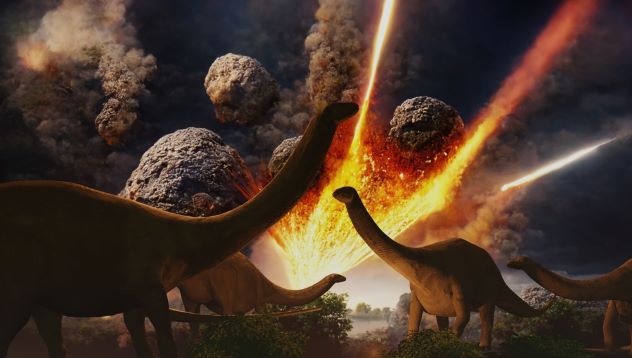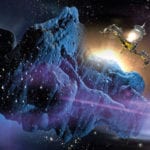 Mysteries
Mysteries  Mysteries
Mysteries  History
History 10 Surprising Stories About the Texas Rangers
 Humans
Humans 10 Philosophers Who Were Driven Mad by Their Own Theories
 Miscellaneous
Miscellaneous 10 Video-Game-Worthy Weapons and Armors from History
 Weird Stuff
Weird Stuff 10 Psychics Who Accurately Predicted Wartime Events
 The Arts
The Arts 10 Pieces of Art Inspired by a Broken Heart
 Health
Health 10 Science Fiction-Sounding New Medical Treatments
 History
History 10 Surprising Facts About the Father of Submarine Warfare
 Space
Space Ten Astonishing New Insights into Alien Worlds
 Weird Stuff
Weird Stuff 10 Bizarre Summer Solstice Rituals Still Practiced Today
 Mysteries
Mysteries Top 10 Haunting Facts About the Ghost Ship MV Alta
 History
History 10 Surprising Stories About the Texas Rangers
 Humans
Humans 10 Philosophers Who Were Driven Mad by Their Own Theories
Who's Behind Listverse?

Jamie Frater
Head Editor
Jamie founded Listverse due to an insatiable desire to share fascinating, obscure, and bizarre facts. He has been a guest speaker on numerous national radio and television stations and is a five time published author.
More About Us Miscellaneous
Miscellaneous 10 Video-Game-Worthy Weapons and Armors from History
 Weird Stuff
Weird Stuff 10 Psychics Who Accurately Predicted Wartime Events
 The Arts
The Arts 10 Pieces of Art Inspired by a Broken Heart
 Health
Health 10 Science Fiction-Sounding New Medical Treatments
 History
History 10 Surprising Facts About the Father of Submarine Warfare
 Space
Space Ten Astonishing New Insights into Alien Worlds
 Weird Stuff
Weird Stuff 10 Bizarre Summer Solstice Rituals Still Practiced Today
10 Startling Facts About the Asteroid That Killed the Dinosaurs
Roughly 66 million years ago, life on Earth faced its greatest challenge. A 6-mile (9.7-kilometer) wide asteroid called Chicxulub slammed into Mexico and famously deleted the dinosaurs and, ultimately, 75% of all species. But the event didn’t simply cause and end with the death of the dinosaurs.
The emerging picture is much more frightening. The asteroid triggered deadly weather no human has ever experienced, including a two-year-long night and baking survivors with deadly UV radiation. But Chicxulub also gave us the Amazon rainforest—and a couple of mysteries. The most intriguing of which is the possibility that the iconic cataclysm was caused by two asteroids, not one.
So let’s discover 10 scary facts about the asteroid that wiped out the dinosaurs.
Related: Top 10 Things You Should Know About Asteroid Collisions With Earth
10 A Strange Global Hail

Carbon beads called cenospheres are a sign of industrial activity. They first appeared during the Industrial Revolution as a result of intense combustion. But then something surprising happened. Somewhere in the world, a scientist held a cenosphere—one that was roughly 65 million years old. Needless to say, no power plants were burning crude oil or coal back then.
The mystery proved to be a worldwide phenomenon. Cenospheres were discovered in New Zealand, Spain, Canada, and Denmark. However, the only clue pointed straight at the infamous asteroid. Wherever researchers found the beads, they also noticed a layer of iridium, an element that is more common in asteroids than the earth’s crust. It is now thought that the iridium dust could be the remains of the actual impact.
In all likelihood, when Chicxulub struck the planet, the force was so insane that it liquified the carbon deep within the earth’s crust. This melted material shot skyward and formed carbon beads in the atmosphere. Scientists estimate that the total amount that fell out of the sky after the impact could be as much as 1.98 quintillion pounds (900 quadrillion kilograms).[1]
9 Instant Acid Oceans
The acid in question is not the metal-eating kind. Instead, it’s got everything to do with pH. While it might sound less scary, when pH levels dropped in the ocean after the impact and water acidity rose, things went horribly wrong for marine life.
A 2019 study showed that previous research was incorrect, having assumed that volcanoes had gradually acidified the waters. As it turns out, the explosion of sulfuric rocks during the event led to acid rain, and these showers instantly altered the pH levels of the oceans.
This new understanding came after researchers found a massive deposit of fossil shells lodged inside clay that had accumulated immediately after the impact. The shells, once belonging to tiny plankton, contained the element boron, which is an accurate way to measure pH. In this case, the boron showed that once the asteroid struck, water acidification rapidly followed.
This change killed off many cornerstone species that other sea creatures relied on, and the deadly effects rippled through every level of the food chain. It’s estimated that nearly half of all marine species did not survive the cataclysm.[2]
8 The Bird Mystery
Dinosaur fans who follow the latest news know that modern birds come from non-avian dinosaurs who survived the cataclysm. However, when you peek under the hood of this fact, things get scratchy between researchers. In 2018, one study highlighted this growing divide among bird experts when a team of scientists suggested that almost no avian species successfully ducked the asteroid.
After using several techniques to trace back the lineages of modern birds, the 2018 project found that none really had tree-dwelling ancestors. Post-impact fossils not only showed that forests drastically declined, which would’ve constituted a major habitat loss for tree-dwelling birds, but that the fossils of these birds were also now conspicuously missing.
This dovetailed neatly with the long-held notion that enduring fires swept through forests after the impact, killing plants and animals alike. The study concluded that all birds alive today come from a few ground-dwelling dinosaurs that probably looked like quails. But other scientists don’t agree, stating that complete deforestation might’ve occurred in the Northern Hemisphere, but it’s harder to believe that all forests—and the birds on their branches—did not survive in the south.[3]
7 A Continental Firestorm
There are facts about the dinosaur-killing asteroid that everyone agrees with. Like the size of the impact crater and that the majority of all living species perished during or after the event. But when it comes to fires connected to the strike—when, where, and how strong—the debate is still ongoing.
One piece of the puzzle fell into place when geoscientists from Brazil, Mexico, and the UK discovered proof of at least one firestorm that had occurred directly after the impact—and it was frightening stuff.
In 2022, they gathered tree samples at a fossil site on the Baja California peninsula. The bark was charred from the impact, but here’s the scary part. These trees were over 1,500 miles (2,500 kilometers) away from the strike zone. Yet, within minutes after the asteroid made contact with the earth, these trees and everything in between them and the impact site were set ablaze, either by a fireball or hot debris raining down. Either way, it triggered a firestorm of epic proportions.[4]
6 6-Month-Long Mega-Earthquake
Gorgonilla Island, near Columbia, revealed another fascinating effect of the Chicxulub impact. In 2014, researchers found a geological feature known as spherule deposits on the island. It consists of layers of sand filled with glass beads and shards. These were formed when the asteroid punched Earth’s crust so hard that pressure and heat melted the soil and scattered the melted materials into the atmosphere. At some point, the blobs fell back to Earth as glass.
A shower of glass is strange, but it was also valuable. More specifically, it revealed that the asteroid had also triggered a mega-earthquake. The area where the glass was found was located below the ocean floor at the time of the disaster, and for the spherules to have wiggled their way down to such a depth meant that the ground shook for a long time. But how long did the earthquake last?
It’s now believed that the mega-earthquake was a monster, lasting for weeks and possibly even months. Signs of damage were also found in Mexico and several locations in the U.S. The energy released was calculated at 1023 joules—roughly 50,000 times more than what the devastating 9.1 Sumatra earthquake released in 2004.[5]
5 Freezing Weather for Years
Experts have always suspected that Earth’s climate cooled after the asteroid struck. This was mainly caused by all the carbon dioxide gas and sulfur that was forced into the atmosphere by the force of the impact. But in 2017, new studies showed that the event released a lot more sulfur than previously thought.
One of the main reasons behind the discovery was fresh research. It showed that old assumptions about the angle at which the asteroid struck were wrong. It didn’t hit the Earth at a 90-degree angle; it was more like 60. This revised angle would’ve caused the impact to release roughly 325 gigatons of sulfur into the air, up to three times more than previous estimates.
The older studies, with their reduced estimates, showed that the number of impact gases in the atmosphere would’ve plunged the world into sub-freezing temperatures for at least three years—so the real consequences were likely much worse.[6]
4 Darkness and Lethal UV
When the asteroid struck, it triggered fires. In turn, the blazes released huge amounts of soot into the air. In 2017, a study found that the consequences of this “soot cloud” were devastating. So many particles became airborne that the world was plunged into darkness for up to two years. The long “night” was possible because of an unfortunate quality that soot has (it can keep itself aloft for a long time).
The darkness would’ve severely interfered with photosynthesis on land and in the ocean, which would’ve wreaked havoc on the food chains in both environments. In addition to killing off plant life (and the animals that depended on them), the soot caused Earth’s temperatures to plummet. Ironically, it also warmed the upper atmosphere to such a degree that the ozone was destroyed. Once the soot vanished, the missing ozone layer allowed harmful doses of ultraviolet light to reach the surface—and the survivors.[7]
3 It Created the Amazon Forest
The Amazon rainforest is the most diverse environment in the world, brimming with spectacular ecosystems, animals, and human history. If the Chicxulub asteroid had missed Earth and the impact never happened, the Amazon would not exist today. This was the conclusion of a study that took 12 years and published its findings in 2012.
According to the researchers, ancient pollen told a grim tale of entire ecosystems being wiped out directly after the impact. It also revealed how life slowly returned and ultimately created the world’s biggest rainforest. The study looked at 53 sites across Columbia, 6,000 fossil leaves, and 50,000 grains of fossil pollen.
The samples revealed that before the impact, South American forests were dominated by conifers and ferns. After the asteroid struck, fire annihilated almost half of the continent’s plant species. The fossils also showed that it took six million years for the forests to fully recover and that the first plants to appear were legumes. The legumes enriched the soil with nitrogen, opening the door to flowering plants and, eventually, the breathtaking Amazon rainforest we know today.[8]
2 The World’s Worst Tsunami
In 2004, the Indian Ocean unleashed one of the biggest tsunamis in modern history. Despite killing over 230,000 people, it paled in comparison to the wave that followed the Mexico impact. The initial energy of the asteroid’s tsunami was reportedly 30,000 bigger than the energy released by the Indian Ocean tidal wave.
In 2022, a well-researched simulation revealed the tsunami’s path. Ten minutes after the asteroid struck, the tsunami started to spread like a pond ring, sweeping the ocean in all directions. Waves were a mile high, and underwater, the force scoured the ocean floor.
By the first hour, it left the Gulf of Mexico and entered the North Atlantic. At the four-hour mark, the waves moved through the Central American Seaway and entered the Pacific. At twenty-four hours, the tsunami had covered most of the Pacific (from the east) and the majority of the Atlantic (from the west). The Indian Ocean was inundated from both sides. Forty-eight hours after the impact, the tsunami flooded most of the world’s shorelines, making it the worst tsunami in recorded history.[9]
1 Two Asteroids, Not One
In 2020, scientists were mapping the ancient seafloor near a volcano called Nadir Seamount when they discovered a feature that resembled an asteroid impact. Nicknamed “Nadir,” it was about 6 miles (10 kilometers) wide and was located on the Guinea Plateau, west of Africa. While it ticked all the boxes to qualify as a genuine asteroid crater, what excited the scientists the most was that Nadir was the same age as Chicxulub.
Additionally, when viewed on a map, the two craters are separated by the Atlantic Ocean, but one could still draw a direct line from Nadir to Chicxulub. Their intriguing locations and similar age prompted the question, “Was the extinction of the dinosaurs caused by two simultaneous asteroid strikes?” For now, more research is needed to determine the relationship between the two asteroids.
Simulations showed that Nadir—which was smaller and had a diameter of 0.24 miles (400 meters)—caused chaos. Once it struck the shallow waters of the Guinea Plateau, the asteroid instantly vaporized. What followed included a column of water almost half a mile (800 meters) thick, a fireball that would’ve been visible from miles away, underwater landslides, tsunamis, shock waves equivalent to a magnitude 7 earthquake, and an air blast bigger than anything in recorded history.[10]







